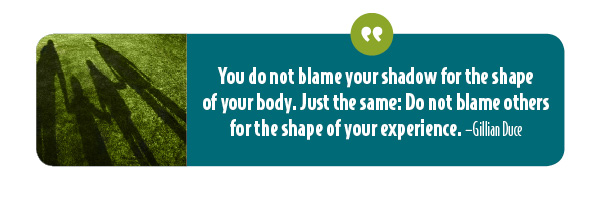Blaming is a common reaction. The blame game used to be one of my primary arsenals. Years ago, whenever I felt overwhelmed, I blamed the dog, my kids, or even the chair in the way when stubbing my toe. Anything in earshot received a rant of blame. "Look what you made me do!"
Hmm. Does anyone or anything really make us do anything?
Estimated reading time: 5 minutes
 So why do we blame?
So why do we blame?
Think about it for a moment.
An intense feeling boils up and out comes the biting remark.
It's takes the heat off of us. And what's the heat?
Painful and uncomfortable feelings. Phew! The hurt stops—temporarily.
Blame Is Shame Turned Inside Out
What we're not doing is taking responsibility to look squarely in the eyes of life—our life. We're not facing whatever is happening at the moment. Instead, we're avoiding. For some reason, we're unwilling or unable to feel the discomfort and accept responsibility.
If we're blaming our husband for feeling lonely, it's time to take responsibility to make quality time together a priority.
If we're blaming the kids for feeling stressed out, perhaps what's needed is a little self-care and some downtime.
Every time we blame, we are not taking accountability for something.
If blaming is a habit of yours, I feel for you. Been there, done that. It's never a good feeling. And the more we blame, the less we change. And the quality of our lives goes down, too.
Whenever you hear yourself say, even under your breath, "Look what you made me do," it's time to check in with what you're feeling. It's time for a self-awareness check-up because no one is to blame, not even you! Blame turned inside out is only shame covered over with pain.
As John Welwood, author of Perfect Love, Imperfect Relationships, so aptly shares:
"At any moment, whatever we are experiencing, only one
of two things is ever happening: either we are being with
what is, or else we are resisting what is. Being with what is
means letting ourselves have and feel our experience."
Accept Feelings as a Roadmap in Your Life
Ready to understand your emotions better? Try our free webinar "How to Use Your Emotions to Make Life-Transforming Change."
 It's human nature to take the easy way out.
It's human nature to take the easy way out.

Steps to Turn Blame into Acceptance and Power
STEP 1: Pause.
Yes, pause and take in a few deep breaths.
The first step of change is to disrupt the hair-trigger reaction and impulse to blame. Once you can prevent lashing out, you can then pause for two more seconds or two hours or two days. This space gives you the power to choose to respond instead of reacting.
STEP 2: Increase your self-awareness.
Get in touch with your feelings and what you're trying to avoid. At first, this may be in retrospect but gradually you will be able to have mindfulness in real time. When we deflect or project onto someone else, we deny ourselves a fabulous opportunity for self-awareness and growth. What did you want to happen or happen differently?
STEP 3: Get curious. What is fueling the blame?
Perhaps you blame your child when you tip over and accidentally break your favorite vase. You may have thought the day before, "I should put that vase in a safer place." You are angry that you didn't act. You're sad that the vase broke. You wanted to keep the vase safe, which was a precious gift from a close friend while visiting Spain.
Or maybe you blame your co-worker for missing an error on a full-page ad that got printed incorrectly when YOU were the one to submit the content wrong. You might be embarrassed by the mistake; you are upset that your high standard of excellence was compromised. You desire to uphold the exemplary track record of your marketing department and company.
Whatever we're wanting is legitimate but blaming doesn't make it different nor can it.
Deep dive: "Blame: a Lazy Response to Avoid Responsibility."
STEP 4: Accept that you are human.
Accidents happen. Mistakes are overlooked. Objects break and we lose our cool. When blame is a part of your arsenal, like it was mine, self-compassion is one of the most vital tools to help eliminate blame.
Take the judgment off of yourself, lean into vulnerability (yes, it might feel uncomfortable, even scary) while taking responsibility for what may go awry or not according to plans.
STEP 5: Brainstorm and rehearse new ways of responding.
One of the primary reasons for blaming is that our values are at risk. Build strategies and habits into your life to ensure that you can live according to what's most important to you.
Blaming others may make us feel better temporarily, but it also disempowers us. If you want to reach for your full potential, stop accusing others, and start accepting responsibility for the quality of your life and relationships. Do your part to create a life you love!
Related reading: "What Is Emotional Intelligence?"
And if you've tried and tried without success, maybe it's time to get some support. Heartmanity's programs have a proven track record to create transformation and permanent change! Try us and see if we're a fit for you. 








